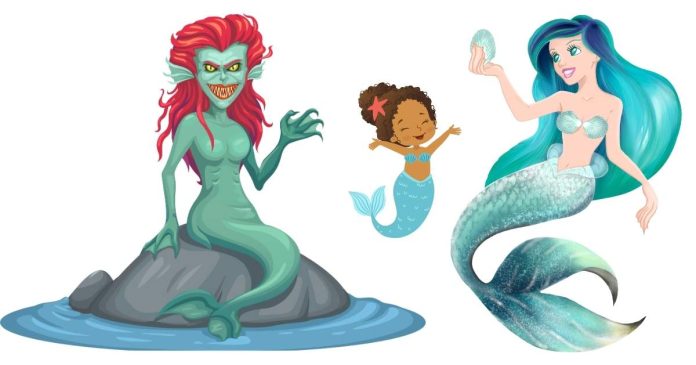Sirens and mermaids are two of the most well-known mythical creatures associated with the sea, but they are often confused or used interchangeably in popular culture. While both are linked to water and share some similarities, their origins, appearances, and roles in mythology and folklore are quite distinct. So, what’s the difference between a siren and a mermaid? Let’s dive into the depths of their histories to find out.
Origins and Mythological Roots
Sirens
The origins of sirens can be traced back to ancient Greek mythology. In their earliest depictions, sirens were not even aquatic beings. Instead, they were bird-like creatures—half woman, half bird—living on rocky islands. They were infamous for their enchanting voices and songs, which lured sailors to shipwreck on their treacherous shores.
Sirens are most famously mentioned in Homer’s Odyssey, where Odysseus ties himself to the mast of his ship to hear their irresistible songs without succumbing to their deadly lure. Over time, as myths evolved and merged, sirens became associated with the sea, giving rise to the confusion with mermaids.
Mermaids
Mermaids, on the other hand, originate from a variety of cultural myths around the world. The earliest mermaid-like figure is Atargatis, a Syrian goddess from around 1000 BCE who transformed into a half-fish, half-woman being. Mermaids typically represent beauty, mystery, and the allure of the sea.
Unlike sirens, mermaids were generally not considered dangerous. They were seen as benevolent (or at least neutral) creatures, though some myths describe them as omens of storms or ill fortune.
Physical Appearance
Sirens
In Greek mythology, sirens were described as bird-like creatures with human faces. However, as their legends evolved, their appearance became more humanoid. In modern interpretations, especially in Western culture, sirens are often portrayed as beautiful women with aquatic traits, such as scaled skin or fins, blurring the line between them and mermaids.
Mermaids
Mermaids are classically depicted as having the upper body of a woman and the lower body of a fish. They are often associated with long flowing hair, graceful movements, and an ethereal beauty. Unlike sirens, their portrayal leans toward being enchanting rather than sinister, though they can be mischievous in some tales.
Behavior and Role in Myths
Sirens
Sirens are universally associated with danger and destruction. Their primary role in myths is to lure sailors to their deaths through their mesmerizing songs. They symbolize temptation, seduction, and the peril of being led astray by desire.
In some interpretations, sirens are also seen as cursed beings, unable to leave their island and doomed to repeat their deadly song for eternity.
Mermaids
Mermaids have a more varied role in myths. They can be protectors of the sea, like the benevolent mermaids in some Asian and African folklore, or harbingers of bad luck, as seen in European maritime traditions.
Some mermaid myths involve them falling in love with humans or saving sailors from drowning, emphasizing their more romantic and mysterious nature.
Cultural Evolution
Over time, the distinction between sirens and mermaids has blurred, especially in literature and pop culture. Movies like Pirates of the Caribbean: On Stranger Tides show sirens as deadly, beautiful sea creatures that resemble mermaids. Meanwhile, stories like The Little Mermaid depict mermaids as gentle and curious beings, far removed from the dangerous allure of sirens.
This conflation of the two has made it harder to separate them in modern storytelling. However, a clear distinction remains in their original mythologies: sirens are dangerous temptresses tied to death and destruction, while mermaids are mystical beings representing beauty and the mysteries of the ocean.
Modern Interpretations
Sirens in Pop Culture
In contemporary media, sirens are often portrayed as aquatic beings who lure humans to their doom. Their seductive and dangerous nature remains a key feature. For example:
- In the TV show Siren, they are complex creatures with a dark, predatory edge.
- In Greek-inspired fantasy stories, their mythical roots as deadly singers persist.
Mermaids in Pop Culture
Mermaids are more often romanticized. From Disney’s The Little Mermaid to depictions in fantasy literature, they are shown as curious, kind-hearted, and yearning for connection with humans. However, darker portrayals also exist, such as in Hans Christian Andersen’s original The Little Mermaid, where the mermaid sacrifices everything for love, with a tragic outcome.
Key Differences at a Glance
| Feature | Sirens | Mermaids |
|---|---|---|
| Origins | Greek mythology | Global folklore |
| Appearance | Half-woman, half-bird (original); later aquatic | Half-woman, half-fish |
| Role | Dangerous, lures sailors to death | Mystical, often benevolent |
| Symbolism | Temptation, danger, and seduction | Beauty, mystery, and curiosity |
| Behavior | Predatory and deadly | Varied: kind, mischievous, or neutral |
While both sirens and mermaids share connections to the sea and carry an aura of mystery, their mythological origins and roles set them apart. Sirens are symbols of danger and temptation, rooted in Greek mythology, while mermaids are magical beings tied to love, beauty, and the unknown depths of the ocean.
Whether you’re drawn to the haunting allure of sirens or the enchanting mystery of mermaids, both remain fascinating symbols of humanity’s enduring fascination with the sea. So, the next time you encounter a tale of a singing sea creature, ask yourself: is it a siren, or is it a mermaid?
Related posts:
- What does ringing in the ears mean spiritually?
- What Colors Do Blue and Green Make?
- How Long Does Raw Chicken Really Last in the Fridge?
- What are some amazing and memorable Valentine’s Day ideas that will leave a lasting impression?
- What is the definition of ‘friends with benefits?
- What is the difference between a bachelor’s and a degree?



